Analysis of Starbucks' International Marketing Strategies & SWOT
VerifiedAdded on 2020/01/28
|5
|996
|59
Report
AI Summary
This report provides a comprehensive analysis of Starbucks' international marketing strategy. It begins with a SWOT analysis, evaluating the company's strengths, weaknesses, opportunities, and threats. The report then delves into the key strategies employed by Starbucks in international markets, including competitive strategies, global marketing mix strategies, and corporate strategies. It examines how Starbucks adapts its products and marketing to suit local tastes and builds a strong brand image. Furthermore, the report offers suggestions for future strategic improvements, such as adopting innovations, expanding digital platforms, and building the Teavana brand. Finally, it discusses factors that influence Starbucks' international market, such as currency rates and acquisition strategies. The report concludes with a list of cited references.
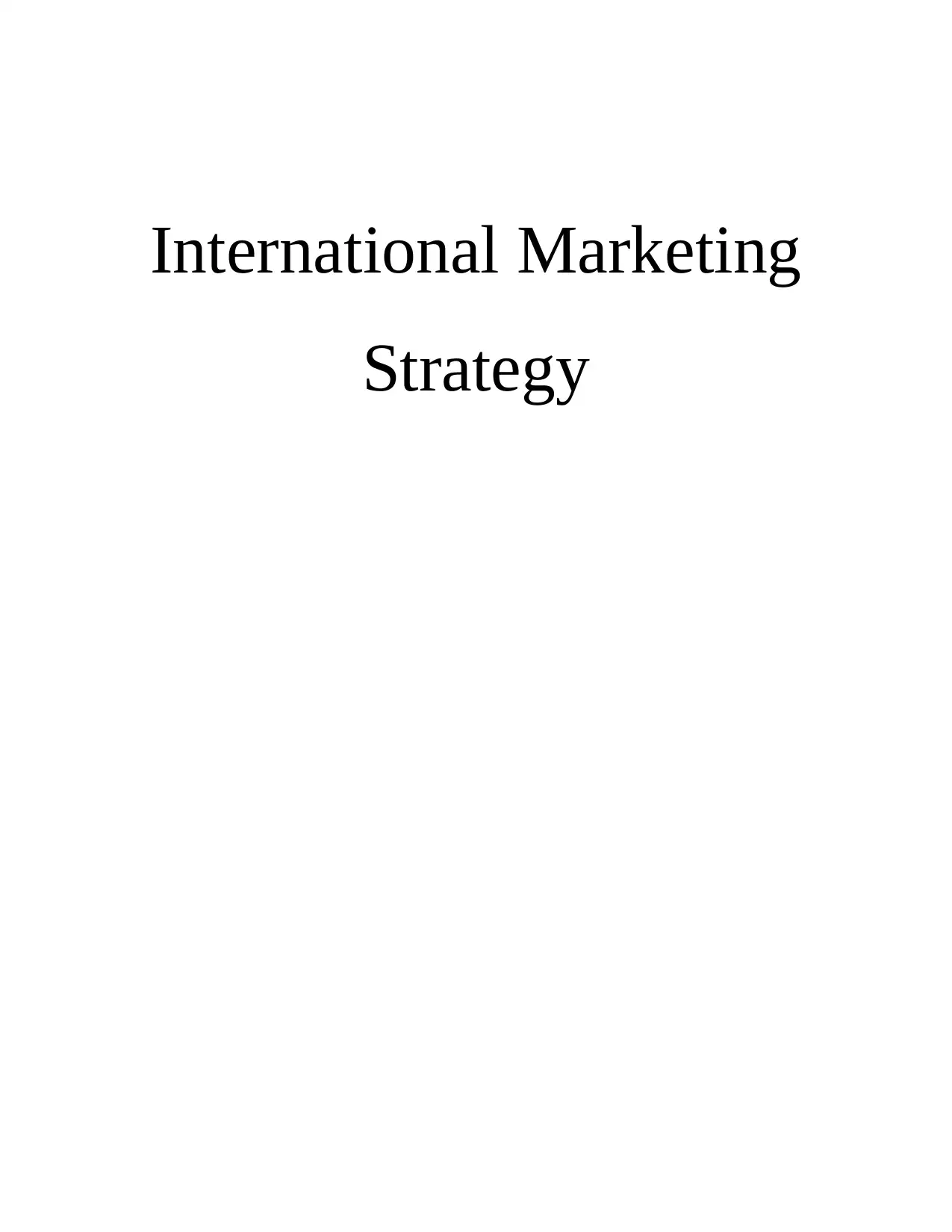
International Marketing
Strategy
Strategy
Paraphrase This Document
Need a fresh take? Get an instant paraphrase of this document with our AI Paraphraser
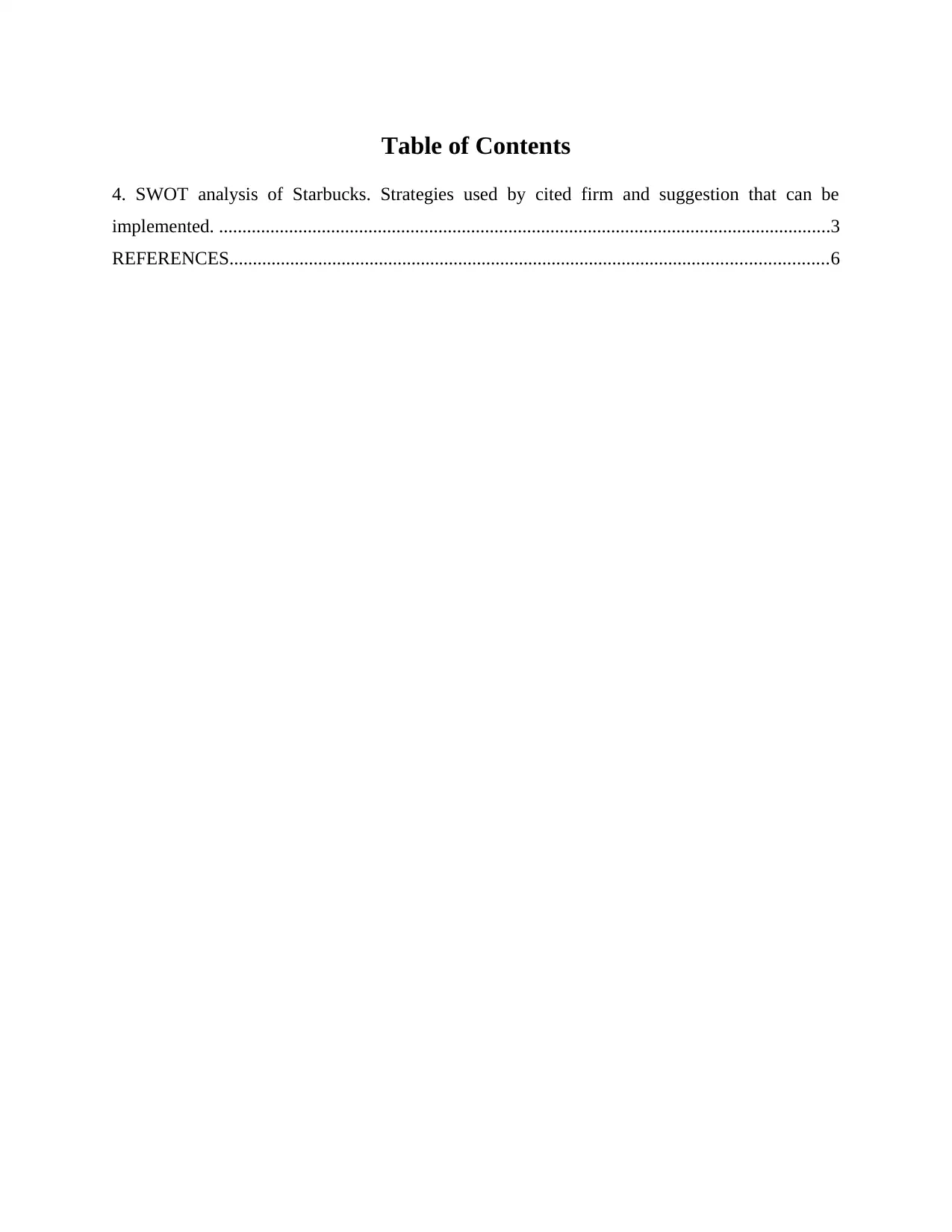
Table of Contents
4. SWOT analysis of Starbucks. Strategies used by cited firm and suggestion that can be
implemented. ...................................................................................................................................3
REFERENCES................................................................................................................................6
4. SWOT analysis of Starbucks. Strategies used by cited firm and suggestion that can be
implemented. ...................................................................................................................................3
REFERENCES................................................................................................................................6
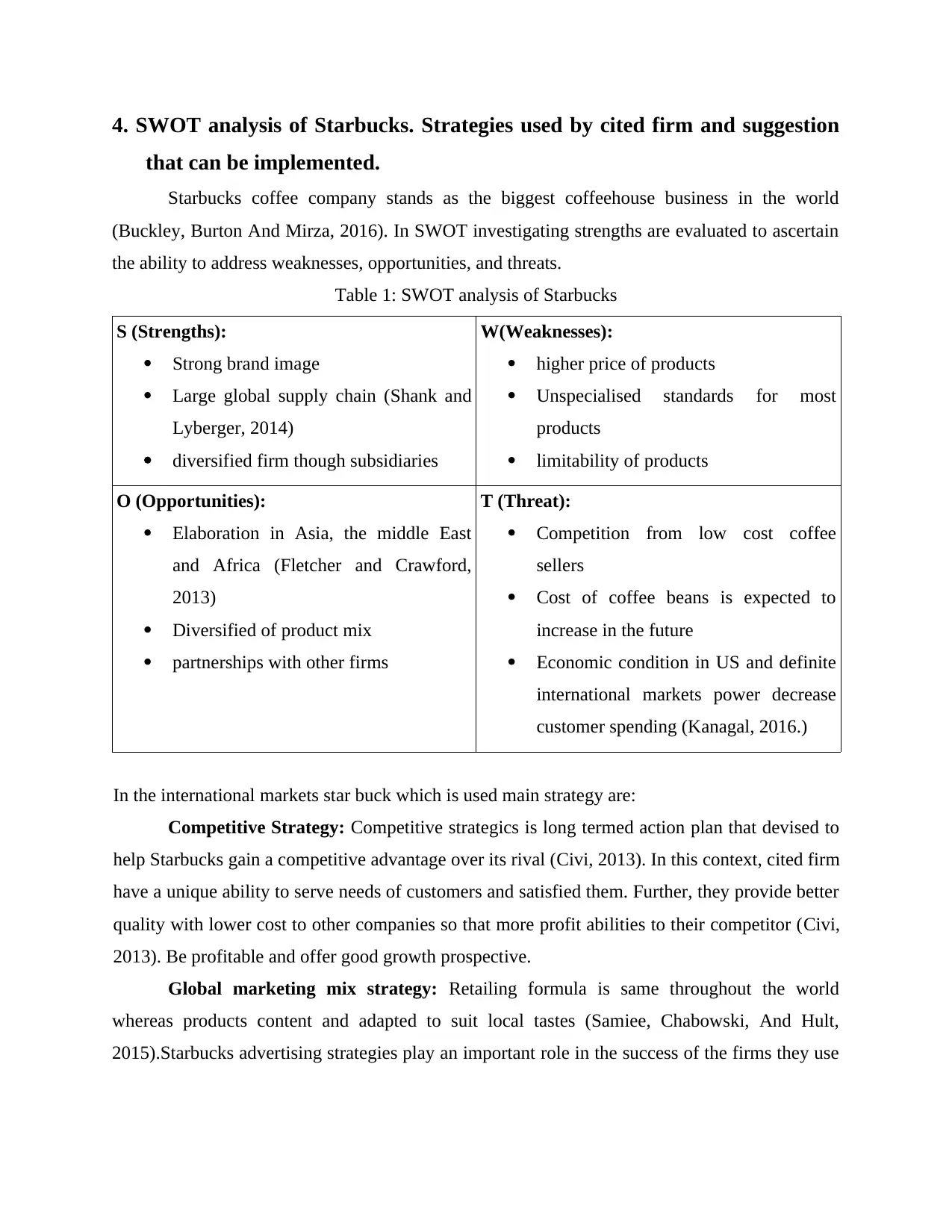
4. SWOT analysis of Starbucks. Strategies used by cited firm and suggestion
that can be implemented.
Starbucks coffee company stands as the biggest coffeehouse business in the world
(Buckley, Burton And Mirza, 2016). In SWOT investigating strengths are evaluated to ascertain
the ability to address weaknesses, opportunities, and threats.
Table 1: SWOT analysis of Starbucks
S (Strengths):
Strong brand image
Large global supply chain (Shank and
Lyberger, 2014)
diversified firm though subsidiaries
W(Weaknesses):
higher price of products
Unspecialised standards for most
products
limitability of products
O (Opportunities):
Elaboration in Asia, the middle East
and Africa (Fletcher and Crawford,
2013)
Diversified of product mix
partnerships with other firms
T (Threat):
Competition from low cost coffee
sellers
Cost of coffee beans is expected to
increase in the future
Economic condition in US and definite
international markets power decrease
customer spending (Kanagal, 2016.)
In the international markets star buck which is used main strategy are:
Competitive Strategy: Competitive strategics is long termed action plan that devised to
help Starbucks gain a competitive advantage over its rival (Civi, 2013). In this context, cited firm
have a unique ability to serve needs of customers and satisfied them. Further, they provide better
quality with lower cost to other companies so that more profit abilities to their competitor (Civi,
2013). Be profitable and offer good growth prospective.
Global marketing mix strategy: Retailing formula is same throughout the world
whereas products content and adapted to suit local tastes (Samiee, Chabowski, And Hult,
2015).Starbucks advertising strategies play an important role in the success of the firms they use
that can be implemented.
Starbucks coffee company stands as the biggest coffeehouse business in the world
(Buckley, Burton And Mirza, 2016). In SWOT investigating strengths are evaluated to ascertain
the ability to address weaknesses, opportunities, and threats.
Table 1: SWOT analysis of Starbucks
S (Strengths):
Strong brand image
Large global supply chain (Shank and
Lyberger, 2014)
diversified firm though subsidiaries
W(Weaknesses):
higher price of products
Unspecialised standards for most
products
limitability of products
O (Opportunities):
Elaboration in Asia, the middle East
and Africa (Fletcher and Crawford,
2013)
Diversified of product mix
partnerships with other firms
T (Threat):
Competition from low cost coffee
sellers
Cost of coffee beans is expected to
increase in the future
Economic condition in US and definite
international markets power decrease
customer spending (Kanagal, 2016.)
In the international markets star buck which is used main strategy are:
Competitive Strategy: Competitive strategics is long termed action plan that devised to
help Starbucks gain a competitive advantage over its rival (Civi, 2013). In this context, cited firm
have a unique ability to serve needs of customers and satisfied them. Further, they provide better
quality with lower cost to other companies so that more profit abilities to their competitor (Civi,
2013). Be profitable and offer good growth prospective.
Global marketing mix strategy: Retailing formula is same throughout the world
whereas products content and adapted to suit local tastes (Samiee, Chabowski, And Hult,
2015).Starbucks advertising strategies play an important role in the success of the firms they use
⊘ This is a preview!⊘
Do you want full access?
Subscribe today to unlock all pages.

Trusted by 1+ million students worldwide
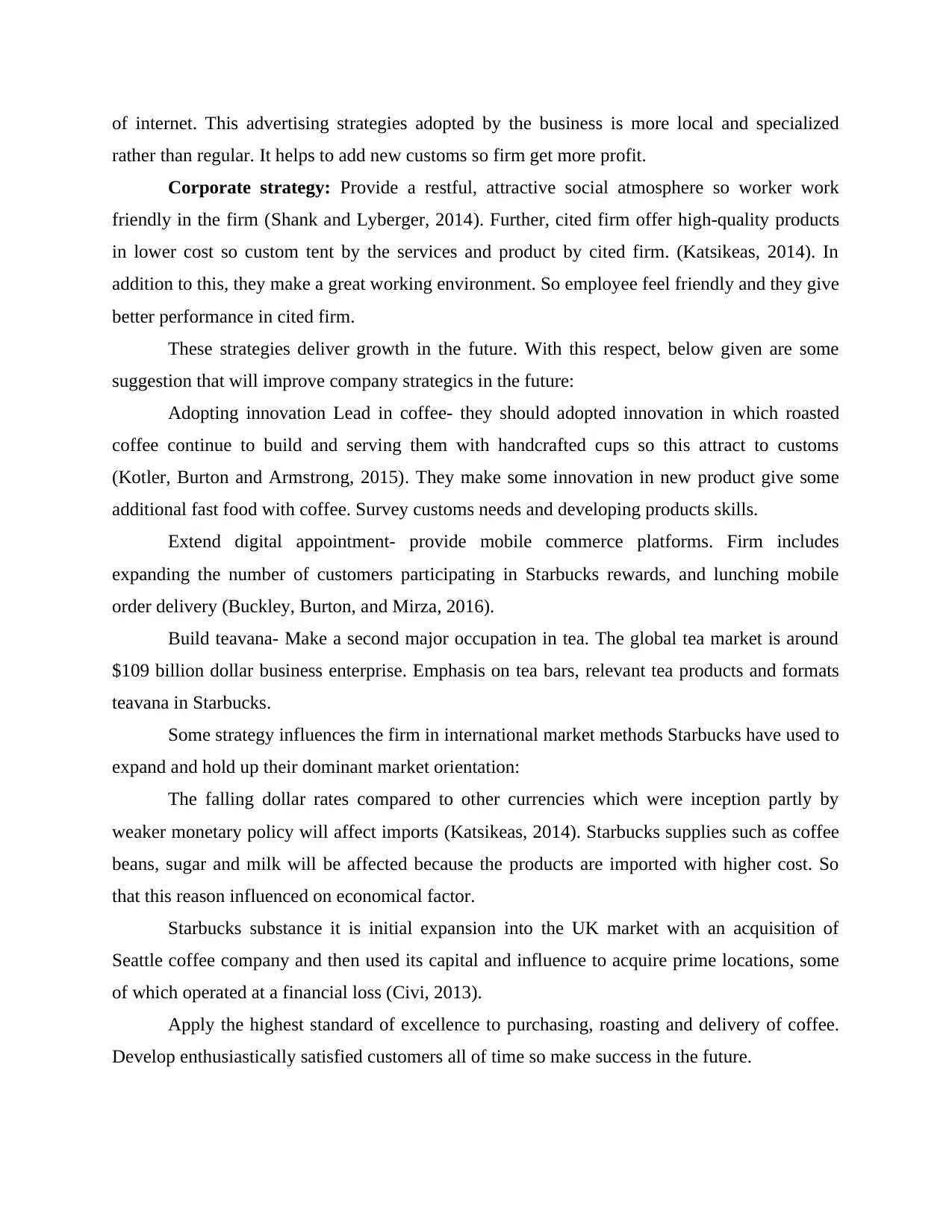
of internet. This advertising strategies adopted by the business is more local and specialized
rather than regular. It helps to add new customs so firm get more profit.
Corporate strategy: Provide a restful, attractive social atmosphere so worker work
friendly in the firm (Shank and Lyberger, 2014). Further, cited firm offer high-quality products
in lower cost so custom tent by the services and product by cited firm. (Katsikeas, 2014). In
addition to this, they make a great working environment. So employee feel friendly and they give
better performance in cited firm.
These strategies deliver growth in the future. With this respect, below given are some
suggestion that will improve company strategics in the future:
Adopting innovation Lead in coffee- they should adopted innovation in which roasted
coffee continue to build and serving them with handcrafted cups so this attract to customs
(Kotler, Burton and Armstrong, 2015). They make some innovation in new product give some
additional fast food with coffee. Survey customs needs and developing products skills.
Extend digital appointment- provide mobile commerce platforms. Firm includes
expanding the number of customers participating in Starbucks rewards, and lunching mobile
order delivery (Buckley, Burton, and Mirza, 2016).
Build teavana- Make a second major occupation in tea. The global tea market is around
$109 billion dollar business enterprise. Emphasis on tea bars, relevant tea products and formats
teavana in Starbucks.
Some strategy influences the firm in international market methods Starbucks have used to
expand and hold up their dominant market orientation:
The falling dollar rates compared to other currencies which were inception partly by
weaker monetary policy will affect imports (Katsikeas, 2014). Starbucks supplies such as coffee
beans, sugar and milk will be affected because the products are imported with higher cost. So
that this reason influenced on economical factor.
Starbucks substance it is initial expansion into the UK market with an acquisition of
Seattle coffee company and then used its capital and influence to acquire prime locations, some
of which operated at a financial loss (Civi, 2013).
Apply the highest standard of excellence to purchasing, roasting and delivery of coffee.
Develop enthusiastically satisfied customers all of time so make success in the future.
rather than regular. It helps to add new customs so firm get more profit.
Corporate strategy: Provide a restful, attractive social atmosphere so worker work
friendly in the firm (Shank and Lyberger, 2014). Further, cited firm offer high-quality products
in lower cost so custom tent by the services and product by cited firm. (Katsikeas, 2014). In
addition to this, they make a great working environment. So employee feel friendly and they give
better performance in cited firm.
These strategies deliver growth in the future. With this respect, below given are some
suggestion that will improve company strategics in the future:
Adopting innovation Lead in coffee- they should adopted innovation in which roasted
coffee continue to build and serving them with handcrafted cups so this attract to customs
(Kotler, Burton and Armstrong, 2015). They make some innovation in new product give some
additional fast food with coffee. Survey customs needs and developing products skills.
Extend digital appointment- provide mobile commerce platforms. Firm includes
expanding the number of customers participating in Starbucks rewards, and lunching mobile
order delivery (Buckley, Burton, and Mirza, 2016).
Build teavana- Make a second major occupation in tea. The global tea market is around
$109 billion dollar business enterprise. Emphasis on tea bars, relevant tea products and formats
teavana in Starbucks.
Some strategy influences the firm in international market methods Starbucks have used to
expand and hold up their dominant market orientation:
The falling dollar rates compared to other currencies which were inception partly by
weaker monetary policy will affect imports (Katsikeas, 2014). Starbucks supplies such as coffee
beans, sugar and milk will be affected because the products are imported with higher cost. So
that this reason influenced on economical factor.
Starbucks substance it is initial expansion into the UK market with an acquisition of
Seattle coffee company and then used its capital and influence to acquire prime locations, some
of which operated at a financial loss (Civi, 2013).
Apply the highest standard of excellence to purchasing, roasting and delivery of coffee.
Develop enthusiastically satisfied customers all of time so make success in the future.
Paraphrase This Document
Need a fresh take? Get an instant paraphrase of this document with our AI Paraphraser
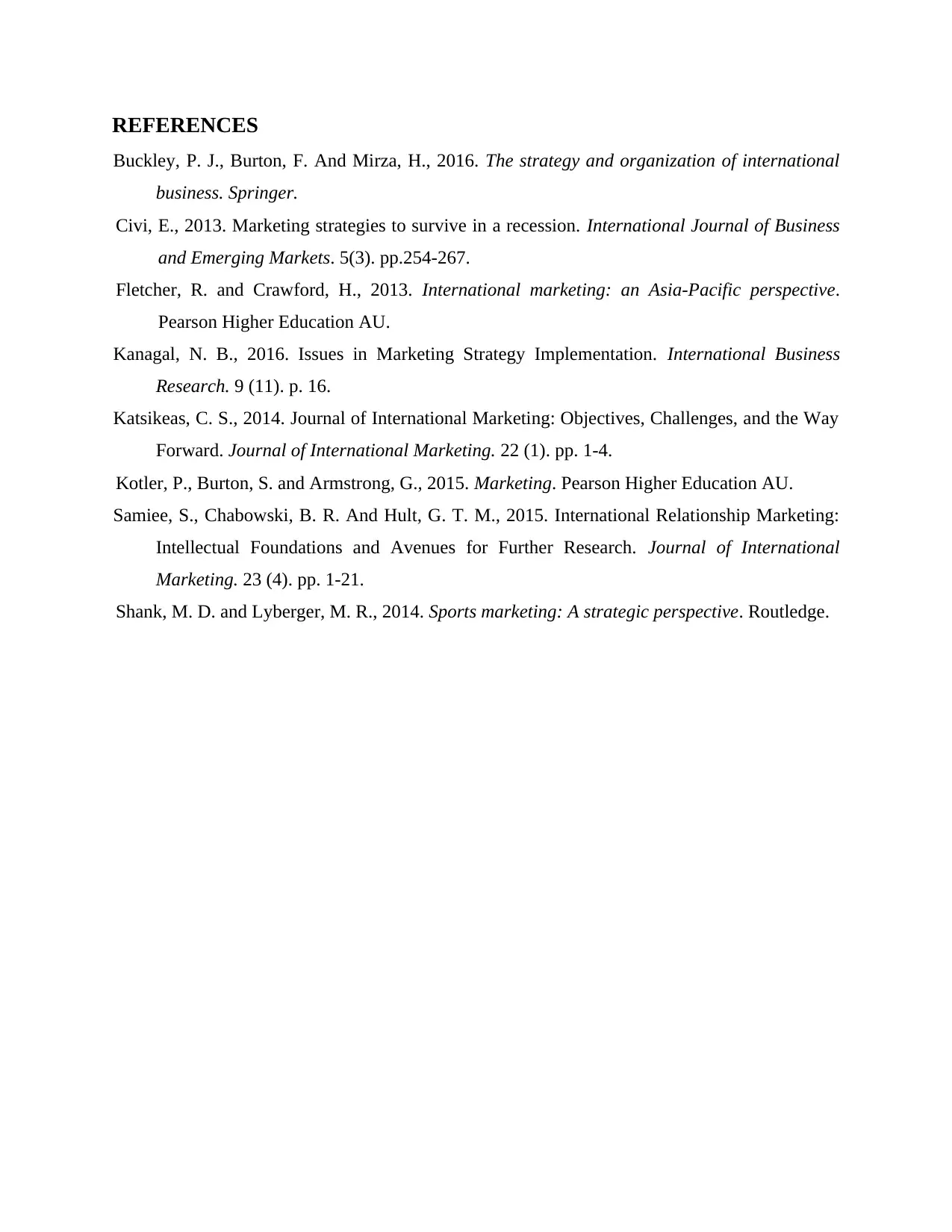
REFERENCES
Buckley, P. J., Burton, F. And Mirza, H., 2016. The strategy and organization of international
business. Springer.
Civi, E., 2013. Marketing strategies to survive in a recession. International Journal of Business
and Emerging Markets. 5(3). pp.254-267.
Fletcher, R. and Crawford, H., 2013. International marketing: an Asia-Pacific perspective.
Pearson Higher Education AU.
Kanagal, N. B., 2016. Issues in Marketing Strategy Implementation. International Business
Research. 9 (11). p. 16.
Katsikeas, C. S., 2014. Journal of International Marketing: Objectives, Challenges, and the Way
Forward. Journal of International Marketing. 22 (1). pp. 1-4.
Kotler, P., Burton, S. and Armstrong, G., 2015. Marketing. Pearson Higher Education AU.
Samiee, S., Chabowski, B. R. And Hult, G. T. M., 2015. International Relationship Marketing:
Intellectual Foundations and Avenues for Further Research. Journal of International
Marketing. 23 (4). pp. 1-21.
Shank, M. D. and Lyberger, M. R., 2014. Sports marketing: A strategic perspective. Routledge.
Buckley, P. J., Burton, F. And Mirza, H., 2016. The strategy and organization of international
business. Springer.
Civi, E., 2013. Marketing strategies to survive in a recession. International Journal of Business
and Emerging Markets. 5(3). pp.254-267.
Fletcher, R. and Crawford, H., 2013. International marketing: an Asia-Pacific perspective.
Pearson Higher Education AU.
Kanagal, N. B., 2016. Issues in Marketing Strategy Implementation. International Business
Research. 9 (11). p. 16.
Katsikeas, C. S., 2014. Journal of International Marketing: Objectives, Challenges, and the Way
Forward. Journal of International Marketing. 22 (1). pp. 1-4.
Kotler, P., Burton, S. and Armstrong, G., 2015. Marketing. Pearson Higher Education AU.
Samiee, S., Chabowski, B. R. And Hult, G. T. M., 2015. International Relationship Marketing:
Intellectual Foundations and Avenues for Further Research. Journal of International
Marketing. 23 (4). pp. 1-21.
Shank, M. D. and Lyberger, M. R., 2014. Sports marketing: A strategic perspective. Routledge.
1 out of 5
Related Documents
Your All-in-One AI-Powered Toolkit for Academic Success.
+13062052269
info@desklib.com
Available 24*7 on WhatsApp / Email
![[object Object]](/_next/static/media/star-bottom.7253800d.svg)
Unlock your academic potential
Copyright © 2020–2025 A2Z Services. All Rights Reserved. Developed and managed by ZUCOL.





